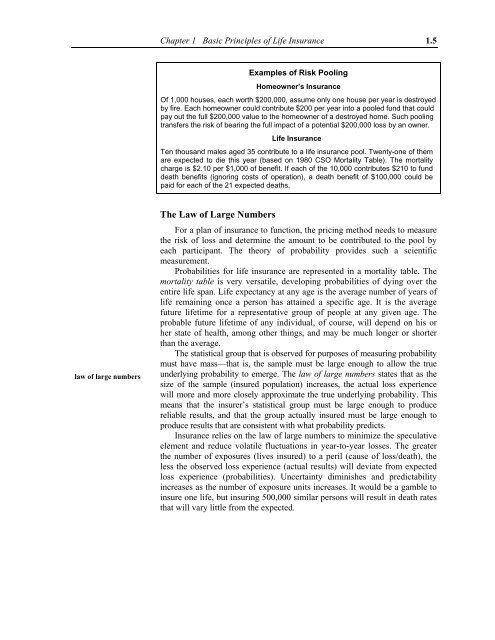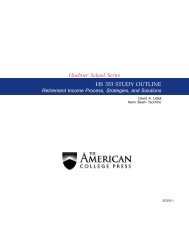Basic Principles of Life Insurance - The American College
Basic Principles of Life Insurance - The American College
Basic Principles of Life Insurance - The American College
Create successful ePaper yourself
Turn your PDF publications into a flip-book with our unique Google optimized e-Paper software.
Chapter 1 <strong>Basic</strong> <strong>Principles</strong> <strong>of</strong> <strong>Life</strong> <strong>Insurance</strong> 1.5<br />
Examples <strong>of</strong> Risk Pooling<br />
Homeowner’s <strong>Insurance</strong><br />
Of 1,000 houses, each worth $200,000, assume only one house per year is destroyed<br />
by fire. Each homeowner could contribute $200 per year into a pooled fund that could<br />
pay out the full $200,000 value to the homeowner <strong>of</strong> a destroyed home. Such pooling<br />
transfers the risk <strong>of</strong> bearing the full impact <strong>of</strong> a potential $200,000 loss by an owner.<br />
<strong>Life</strong> <strong>Insurance</strong><br />
Ten thousand males aged 35 contribute to a life insurance pool. Twenty-one <strong>of</strong> them<br />
are expected to die this year (based on 1980 CSO Mortality Table). <strong>The</strong> mortality<br />
charge is $2.10 per $1,000 <strong>of</strong> benefit. If each <strong>of</strong> the 10,000 contributes $210 to fund<br />
death benefits (ignoring costs <strong>of</strong> operation), a death benefit <strong>of</strong> $100,000 could be<br />
paid for each <strong>of</strong> the 21 expected deaths.<br />
law <strong>of</strong> large numbers<br />
<strong>The</strong> Law <strong>of</strong> Large Numbers<br />
For a plan <strong>of</strong> insurance to function, the pricing method needs to measure<br />
the risk <strong>of</strong> loss and determine the amount to be contributed to the pool by<br />
each participant. <strong>The</strong> theory <strong>of</strong> probability provides such a scientific<br />
measurement.<br />
Probabilities for life insurance are represented in a mortality table. <strong>The</strong><br />
mortality table is very versatile, developing probabilities <strong>of</strong> dying over the<br />
entire life span. <strong>Life</strong> expectancy at any age is the average number <strong>of</strong> years <strong>of</strong><br />
life remaining once a person has attained a specific age. It is the average<br />
future lifetime for a representative group <strong>of</strong> people at any given age. <strong>The</strong><br />
probable future lifetime <strong>of</strong> any individual, <strong>of</strong> course, will depend on his or<br />
her state <strong>of</strong> health, among other things, and may be much longer or shorter<br />
than the average.<br />
<strong>The</strong> statistical group that is observed for purposes <strong>of</strong> measuring probability<br />
must have mass—that is, the sample must be large enough to allow the true<br />
underlying probability to emerge. <strong>The</strong> law <strong>of</strong> large numbers states that as the<br />
size <strong>of</strong> the sample (insured population) increases, the actual loss experience<br />
will more and more closely approximate the true underlying probability. This<br />
means that the insurer’s statistical group must be large enough to produce<br />
reliable results, and that the group actually insured must be large enough to<br />
produce results that are consistent with what probability predicts.<br />
<strong>Insurance</strong> relies on the law <strong>of</strong> large numbers to minimize the speculative<br />
element and reduce volatile fluctuations in year-to-year losses. <strong>The</strong> greater<br />
the number <strong>of</strong> exposures (lives insured) to a peril (cause <strong>of</strong> loss/death), the<br />
less the observed loss experience (actual results) will deviate from expected<br />
loss experience (probabilities). Uncertainty diminishes and predictability<br />
increases as the number <strong>of</strong> exposure units increases. It would be a gamble to<br />
insure one life, but insuring 500,000 similar persons will result in death rates<br />
that will vary little from the expected.
















